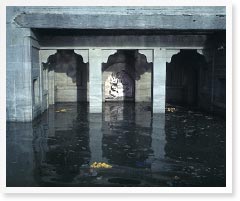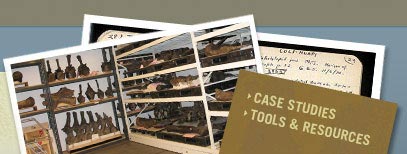Risk Management and Disaster Planning
Whether personal or institutional, all collections are subject to risks that can seriously affect the lifetime and value of a collection. Evaluation tools in the field of “Risk Management”, developed for use in the insurance industry, are increasingly used by museums and universities to identify the greatest risks to their collections and to set procedures in place to plan for and reduce the effects of unavoidable disasters.
In the wake of recent world events, institutions have learned that they must prepare to be able to respond in the case of a disaster – whether natural or manmade. This process is known as disaster planning. While the word “disaster” may imply a major event, such as floods, fires, or earthquakes, most collection disasters are much smaller in scale – flooding from a burst pipe, for example. There are numerous resources available online that can be of use to both individual collectors and collection managers, but a brief outline of risk factors and elements of an appropriate disaster plan are given here.
Risk assessment
A risk assessment – whether formal or informal, extensive or just on a representative portion of a collection, is generally an administrative tool to prioritize the implementation of measures to preserve the collection. The goal is to hopefully prevent damage or, at least, to limit the extent of the damage.
The most common risks to museum collections include:
- Physical forces (earthquakes, physical damage from staff, vibrations from drawers, repair work
- Fire (flame, soot)
- Water (floods, plumbing or roof leak)
- Criminal (robbery, isolated theft, vandalism)
- Pests (rodents, insects)
- Contaminants (dust, gasses)
- Light and UV radiation
- Incorrect temperature
- Incorrect relative humidity
- Custodial neglect (data loss, misplacement, sample mixing)
The goal of conducting a collections risk assessment is to determine:
- What percentage of the collection is susceptible to a specific risk?
- What will be the resulting loss in value?
- What is the probability of the event happening?
- What would be the extent of the event?

Disaster planning
In the event that a disaster, whether large or small, could not be prevented, individuals and institutions must be prepared to respond appropriately to assure safety of personnel and collections and their associated data, and then salvage whatever can be saved. For this to happen effectively, a plan must already be in place — during a disaster is no time to plan. For information on the elements in a disaster plan, see the downloads and links below.
For more Information…
See the following links and resources.
Risk management
- Museum SOS – a website for disaster preparation and response
- Risk Assessment Of Collections In Exhibitions At The Canadian Museum Of Nature by Garnet Muething, Robert Waller, & Fiona Graham JAIC 2005, Volume 44, Number 3, Article 7 (pp. 233 to 243)
- Information on training workshops offered by the Canadian Museum of Nature on Assessing and Managing Risks to Your Collections
- The Minnesota Historical Society offers a technical leaflet to assist small museums in developing a risk management program. It includes checklists with essential elements for 8 program areas, including insurance, guards, fire protection, security, and locks & keys.
- The Alliance for Nonprofit Management has FAQs on risk management. which address types of risk, strategies for controlling risk, the board's role in managing risk, and myths about liability as well as insurance, employment-related claims, fundraising risk, and invasion of privacy, etc..
- The Nonprofit Risk Management Center has an online risk assessment tool; an online risk management tutorial and a Resource Center, which offers fact sheets on risk management, liability, and insurance. The Resource Center also provides free technical assistance to nonprofits.
- The Public Entity Risk Institute provides information and online tutorials with forms and checklists.
Disaster planning
- Museum SOS a website for has extensive information on disaster response and salvage
- The Central New York Library Resources Council (CLRC) website has useful information including a pdf In the Face of Disaster. which addresses collection priorities, building audits to eliminate potential disasters, insurance, response plans, and salvage priorities and techniques. Worksheets and checklists are included to guide an organization's work are in a separate document.
- FEMA offers Integrating Historic Property & Cultural Resource Considerations into Hazard Mitigation Planning, a how-to guide with tools & resources to develop & implement strategies for historic properties & cultural resources.
- The Minnesota Historical Society offers help developing disaster plans for historic properties that can be adapted to other institutions. Topics include wind, flood, fire, and snow & ice.
- The Northeast Document Conservation Center (NEDCC) and the Massachusetts Board of Library Commissioners share dPlan, a free online program to help institutions write comprehensive disaster plans. Templates for museums of all sizes to develop a customized plan with checklists; salvage priorities; preventive maintenance schedules; contact information for personnel, insurance, and IT help; and a list of emergency supplies and services are included. They also maintain a list of Emergency Management Suppliers & Services suppliers and services that will help in the event of a disaster.
- NEDCC also offers the following technical leaflets to assist in developing a disaster plan.
- Disaster Planning is an overview of issues to consider when developing a plan: decreasing risks, identifying resources, and setting priorities. It includes a bibliography and a list of basic supplies and equipment to have on hand.
- Emergency Management Bibliography is an annotated bibliography of publications on planning, preparedness, and recovery.
- Worksheet for Outlining a Disaster Plan is for identifying equipment and services needed for disaster preparedness and recovery, setting salvage priorities, and scheduling drills.
- Introduction to fire detection, alarm, and automatic fire sprinklers
- Protection from Loss: Water and Fire Damage, Biological Agents, Theft, and Vandalism
- The National Archives & Records Administration’ fire safety self-inspection form can be used by museums to identify areas of fire risk.
- The Nonprofit Risk Management Center’s website has a page with information useful (including checklists and a sample plan) in developing an emergency evacuation strategy.
- The Occupational Safety & Health Administration (OSHA) provides 2 useful fact sheets. One on fire prevention plans, and the second on emergency exit routes.
- The Conservation Online website (CoOL) has an article Protecting Your Institution From Wild Fires: Planning Not to Burn and Learning to Recover that offers tips on preventive measures and recovery.



